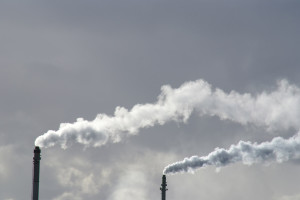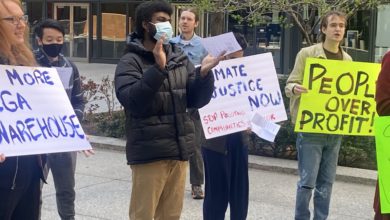 According to the annual Greenhouse Gas Bulletin compiled by the World Meteorological Organization’s Global Atmosphere Watch network, (an agency of the United Nations,) greenhouse gases in the atmosphere are at an all time high.“This year’s Bulletin found the “concentration of carbon dioxide (CO2) in the atmosphere was 142 percent of pre-1750 levels (the beginning of the industrial era), while methane and nitrous oxide (N2O) were 253 percent and 121 percent, respectively.
According to the annual Greenhouse Gas Bulletin compiled by the World Meteorological Organization’s Global Atmosphere Watch network, (an agency of the United Nations,) greenhouse gases in the atmosphere are at an all time high.“This year’s Bulletin found the “concentration of carbon dioxide (CO2) in the atmosphere was 142 percent of pre-1750 levels (the beginning of the industrial era), while methane and nitrous oxide (N2O) were 253 percent and 121 percent, respectively.
“The analysis showed that between 2012 and 2013 CO2 levels increased more than in any other year since 1984. Globally the amount of CO2 in the atmosphere hit 360 parts per million in 2013, an increase of 2.9 parts per million since 2012. The symbolic milestone of 400 parts per million will likely be reached in either 2015 or 2016. “ (“Level of greenhouse gases in atmosphere reaches record high in 2013 – UN agency” RT Sept. 9)
The bulletin reports on concentrations of three gases: Carbon dioxide (CO2), methane and nitrous oxide (N2O). CO2 is implicated in 80 percent of the increase in radiative forcing, or the amount of sunlight reflected back into space and not absorbed by the atmosphere.
Methane is the second longest lasting greenhouse gas after CO2. While a lot of methane comes from natural sources, 60 percent of methane comes from human activity including cattle breeding, landfills, biomass and fossil fuel extraction. In 2013 methane hit a record high of 1,824 parts per billion.
Finally, N2O plays a major role in the atmosphere, where it destroys the ozone layer which protects the earth and its people from the ultraviolet rays of the sun. About 40 percent of N2O comes from industrial processes and fertilizer use.
The point of all this is that we are facing a crisis—a tipping point if you will—where we have to make dramatic changes in order to avoid or at least mitigate the worst effects of global climate change.
As scientist Chris Williams puts it:
“So for the whole of human civilization, the last 10,000 years and longer, then the Earth has had an average amount of carbon in the atmosphere of about 280 molecules of carbon dioxide per million molecules of air, as it were. So that’s been steadily increasing. And there are lots of graphs to show how that has been happening, to the extent that we’re now at 400 parts per million.
“And if we want to stay within 2 degrees Celsius of average warming from 150 years ago to today–and we’ve already seen about 1 degree so far–then we need to get back down to 350. And if you burn things with carbon in them, they inevitably turn into carbon dioxide. So every type of fossil fuel that we burn, which is responsible for the vast majority of energy, electricity, transportation, etc., is putting extra carbon into the atmosphere.
“And that particular molecule happens to have this other characteristic, that it will allow heat from the sun in and energy, light, etc., but when it reflects outwards as infrared radiation, it blocks a higher percentage, hence kind of the greenhouse type analogy that has been used to make the connection to how a greenhouse works, essentially by trapping extra heat. So, obviously, the atmosphere has to stay at an average temperature, and as much energy and [heat] as comes in has to really leave at the same time. And now we’re finding less energy is leaving than is coming in. And that’s why the overall average temperature is warming. It’s going to be 2 degrees in some places. In other places, like the Arctic, it could be up to 6 or 8 degrees Celsius, which would be absolutely disastrous. And so we’re on track not just for 2 degrees Celsius, but actually, according to the World Bank, 4 Celsius.” (The Real News)
Williams goes on to explain the consequences of this increase in temperatures.
“Within the lifetime of many people, 80 percent of the population alive today, we’ll see significant changes to the way in which their region behaves with regard to rainfall patterns, with regard to how many hot days there are, how many days above 90 Fahrenheit, how many days above 100 Fahrenheit, which has all kinds of other knock-on effects in terms of air conditioning, in terms of also what we saw this winter in the Midwest with the polar vortex and the destabilization of the jet streams, which is being linked to climate change. So there are an intensification of hurricanes. If you’ve got more heat in the atmosphere, then the logical corollary of that is more energy, right? And that’s what it takes, one of the things that it takes to [build big hurricanes.]” (The Real News)
Thus, as a human species, we need to drastically curtail our extraction and use of fossil fuels, as well as make other systemic changes that will reduce the emissions of greenhouse gases. If this doesn’t happen, we are facing disaster.
But what do our so-called leaders do? They refuse to act. The U.S., historically responsible for a large percentage of the global warming-causing emissions, has dragged its feet on meaningful change, choosing instead to point the finger at China, a comparatively poor country in the process of development. While nothing is to be allowed to stand in the way of ongoing profitability for U.S. economy, China is supposed to freeze its development, although the fact that China is underdeveloped is a product of past colonial exploitation.
What needs to be understood is that the crisis is a direct outgrowth of capitalist economic development. And the system is incapable of reforming itself. Williams says:
“I don’t think that there’s a complete solution or answer under capitalism.”
So, what are we supposed to do? Scientist Chris Willliams puts it quite well: “I don’t know whether people are waiting for Bruce Willis or not, but he’s not going to turn up. And so it really is down to us to make a change.”






